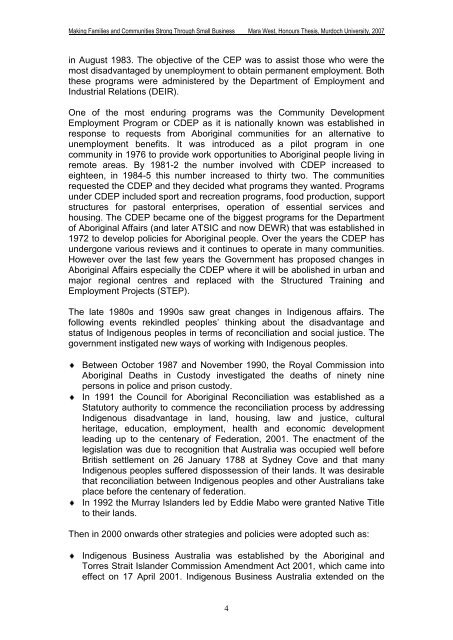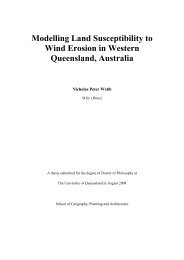MAKING FAMILIES AND COMMUNITIES STRONG THOUGH SMALL BUSINESS
making families and communities strong though small ... - Ninti One
making families and communities strong though small ... - Ninti One
- No tags were found...
You also want an ePaper? Increase the reach of your titles
YUMPU automatically turns print PDFs into web optimized ePapers that Google loves.
Making Families and Communities Strong Through Small Business Mara West, Honours Thesis, Murdoch University, 2007in August 1983. The objective of the CEP was to assist those who were themost disadvantaged by unemployment to obtain permanent employment. Boththese programs were administered by the Department of Employment andIndustrial Relations (DEIR).One of the most enduring programs was the Community DevelopmentEmployment Program or CDEP as it is nationally known was established inresponse to requests from Aboriginal communities for an alternative tounemployment benefits. It was introduced as a pilot program in onecommunity in 1976 to provide work opportunities to Aboriginal people living inremote areas. By 1981-2 the number involved with CDEP increased toeighteen, in 1984-5 this number increased to thirty two. The communitiesrequested the CDEP and they decided what programs they wanted. Programsunder CDEP included sport and recreation programs, food production, supportstructures for pastoral enterprises, operation of essential services andhousing. The CDEP became one of the biggest programs for the Departmentof Aboriginal Affairs (and later ATSIC and now DEWR) that was established in1972 to develop policies for Aboriginal people. Over the years the CDEP hasundergone various reviews and it continues to operate in many communities.However over the last few years the Government has proposed changes inAboriginal Affairs especially the CDEP where it will be abolished in urban andmajor regional centres and replaced with the Structured Training andEmployment Projects (STEP).The late 1980s and 1990s saw great changes in Indigenous affairs. Thefollowing events rekindled peoples’ thinking about the disadvantage andstatus of Indigenous peoples in terms of reconciliation and social justice. Thegovernment instigated new ways of working with Indigenous peoples.Between October 1987 and November 1990, the Royal Commission intoAboriginal Deaths in Custody investigated the deaths of ninety ninepersons in police and prison custody.In 1991 the Council for Aboriginal Reconciliation was established as aStatutory authority to commence the reconciliation process by addressingIndigenous disadvantage in land, housing, law and justice, culturalheritage, education, employment, health and economic developmentleading up to the centenary of Federation, 2001. The enactment of thelegislation was due to recognition that Australia was occupied well beforeBritish settlement on 26 January 1788 at Sydney Cove and that manyIndigenous peoples suffered dispossession of their lands. It was desirablethat reconciliation between Indigenous peoples and other Australians takeplace before the centenary of federation.In 1992 the Murray Islanders led by Eddie Mabo were granted Native Titleto their lands.Then in 2000 onwards other strategies and policies were adopted such as:Indigenous Business Australia was established by the Aboriginal andTorres Strait Islander Commission Amendment Act 2001, which came intoeffect on 17 April 2001. Indigenous Business Australia extended on the4
















